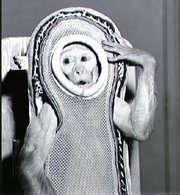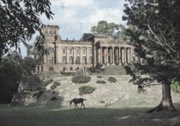German School of Re-Design
From Plastic Tub
|
Famed School of Industrial Readiness and Colloquial Design, established by German AA dissidents in Costa Rica. Closely associated with the "rat-lines" which allowed Nazi officials to escape the fall of Germany, the school taught a severe, unbending approach to the arts, specifically those areas of expression deemed "irrevocably intolerable." In short, an idealism reigned supreme, the goal of which was no less than the "proper redesign of intolerable artifacts so prevalent in the decadent societies of the West." The school was mad about re-designing everything from the toothbrushes to the foot-saucer. Easton W. Wunderkidd nearly bankrupted the school in his South American Adventures Of 1948. Anti-Thesis The faculty was reknowned and included everything from industrial designers to choreographers. Juan Castillo (Professor of Dance), for example, was roundly applauded for his intricate use of the goose-step in the Tango. His cohort Pedro Wiggins introduced the Nazi salute into the dance. Though many will deny the true origins, their moves can be found in milongas over the world to this day. Although many of the School's projects were doomed to failure Early hunimal experiment at the German School of Re-Design. Today the School's 27-acre campus outside of San Juan bristles with life as nearly 3000 students carry out cutting edge research in over 30 disciplines. It is a fully accredited learning institution. In addition to its central educational mission, the School has small but well-regarded programs for the arts and music, sports and jungle exploration. Hermenuetics High The school was not without its darkside. During the years after WWII many of the professors and students engaged in many concerted acts of rebellion. The School's rigorous modern curriculum still held tightly to the major attitudes of the Third Reich, especially concerning the visual arts and experimental and/or electronic music. The students subverted the system by holding clandestine symposiums in the underground bunkers beneath the jungle. In the boiler rooms beneath the campus they arranged artshows for the mentally challenged, the illiterate, the retarded. Mystery Date These events were often highlighted by Dionysian frenzies stimulated by electronic tones (arranged in primitive intervals) and the premier South American hallucinagen Ayahuasca. Over time, the participants fractioned out into smaller factions. In the beginning the rebellions were liberating and transcendent but soon became marred by transgressive violence and quickly shifted to its decadent stages. Although many of the factions disbanded after the South American Adventures Of 1948 there are rumors about a certain faction that fled the school for the jungle where they began their transformation back to the primitive. [edit] See Also |
[edit] DesiderataSquare watermelons, now all the rage in upscale "produce boutiques", hail from the GSRD. The inverted umbrella was a less sucessful venture. |

